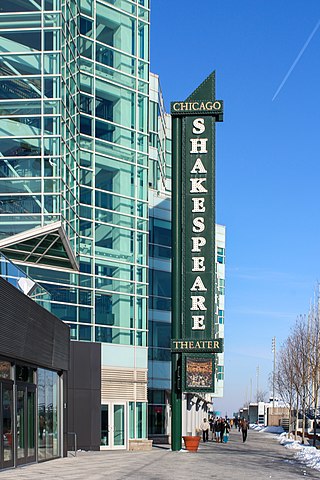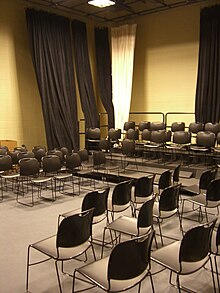
The following outline is provided as an overview of and topical guide to theatre:

A proscenium is the metaphorical vertical plane of space in a theatre, usually surrounded on the top and sides by a physical proscenium arch and on the bottom by the stage floor itself, which serves as the frame into which the audience observes from a more or less unified angle the events taking place upon the stage during a theatrical performance. The concept of the fourth wall of the theatre stage space that faces the audience is essentially the same.

A theatre in the round, arena theatre, or central staging is a space for theatre in which the audience surrounds the stage.

Stagecraft is a technical aspect of theatrical, film, and video production. It includes constructing and rigging scenery; hanging and focusing of lighting; design and procurement of costumes; make-up; stage management; audio engineering; and procurement of props. Stagecraft is distinct from the wider umbrella term of scenography. Considered a technical rather than an artistic field, it is primarily the practical implementation of a scenic designer's artistic vision.

Experimental theatre, inspired largely by Wagner's concept of Gesamtkunstwerk, began in Western theatre in the late 19th century with Alfred Jarry and his Ubu plays as a rejection of both the age in particular and, in general, the dominant ways of writing and producing plays. The term has shifted over time as the mainstream theatre world has adopted many forms that were once considered radical.

In theatre and performing arts, the stage is a designated space for the performance of productions. The stage serves as a space for actors or performers and a focal point for the audience. As an architectural feature, the stage may consist of a platform or series of platforms. In some cases, these may be temporary or adjustable but in theaters and other buildings devoted to such productions, the stage is often a permanent feature.
Main stage or mainstage refers to the largest or most prestigious space of a theatre building and to the productions performed in that space. Mainstage theatre has been historically distinguished from smaller-scale studio theatre. It is usually performed in a proscenium theatre or on a thrust stage. Main stage is also used to describe the performance space with the largest audience capacity at a performing arts festival or other venues.

A theater, or playhouse, is a structure where theatrical works, performing arts, and musical concerts are presented. The theater building serves to define the performance and audience spaces. The facility usually is organized to provide support areas for performers, the technical crew and the audience members, as well as the stage where the performance takes place.

Chicago Shakespeare Theater (CST) is a non-profit, professional theater company located at Navy Pier in Chicago, Illinois. Its more than six hundred annual performances performed 48 weeks of the year include its critically acclaimed Shakespeare series, its World's Stage touring productions, and youth education and family oriented programming. The theater had garnered 77 Joseph Jefferson awards and three Laurence Olivier Awards. In 2008, it was the winner of the Regional Theatre Tony Award.

A catwalk is an elevated service platform from which many of the technical functions of a theater, such as lighting and sound, may be manipulated.

A fly system, or theatrical rigging system, is a system of ropes, pulleys, counterweights and related devices within a theater that enables a stage crew to fly (hoist) quickly, quietly and safely components such as curtains, lights, scenery, stage effects and, sometimes, people. Systems are typically designed to fly components between clear view of the audience and out of view, into the large space, the fly loft, above the stage.

Adolphe Appia was a Swiss architect and theorist of stage lighting and décor. He was the son of Red Cross co-founder Louis Appia.

Theater drapes and stage curtains are large pieces of cloth that are designed to mask backstage areas of a theater from spectators. They are designed for a variety of specific purposes, moving in different ways and constructed from various fabrics. Many are made from black or other darkly colored, light-absorbing material. Theater drapes represent a portion of any production's soft goods, a category comprising any non-wardrobe, cloth-based element of the stage or scenery. Theater curtains are often pocketed at the bottom to hold weighty chain or to accept pipes to remove their fullness and stretch them tight.
Performing arts – are art forms where the participant engages in a physical performance using their body, voice, language, or use of specific equipment for entertainment purposes.
The Naples Players (TNP) is a community theatre company located in Naples, Florida. The company was founded on January 19, 1953 in the Sugden Community Theatre at 701 5th Avenue South in downtown Naples. It has been named the "Best Live Theatre" in Southwest Florida (including professional theaters) fifteen times by the readers poll of The Naples Daily News.
Situated in the heart of Fort Collins, The Lincoln Center is the premier multi-venue performing and visual arts center in Northern Colorado. It was founded in 1978 through a community initiative called “Designing Tomorrow Today” that resulted in a voter-approved $2.2 million capital improvements tax, with the community raising an additional $300,000 to complete a new performing and visual arts center for Fort Collins.
There are different types of theatres, but they all have three major parts in common. Theatres are divided into two main sections, the house and the stage; there is also a backstage area in many theatres. The house is the seating area for guests watching a performance and the stage is where the actual performance is given. The backstage area is usually restricted to people who are producing or in the performance.
Theatre in the nineteenth century was noted for its changing philosophy, from the Romanticism and Neoclassicism that dominated Europe since the late 18th century, to Realism and Naturalism in the latter half of the 19th century, before it eventually gave way to the rise of Modernism in the 20th century. Scenery in theater at the time closely mirrored these changes and with the onslaught of the Industrial Revolution and technological advancement throughout the century, dramatically changed the aesthetics of the theater.
Theatre in the nineteenth century was noted for its changing philosophy from the Romanticism and Neoclassicism that dominated Europe since the late 18th century to Realism and Naturalism in the latter half of the 19th century before it eventually gave way to the rise of Modernism in the 20th century. Scenery in theater at the time closely mirrored these changes, and with the onset of the Industrial Revolution and technological advancement throughout the century, dramatically changed the aesthetics of the theater.

The Hilberry Gateway is a performing arts center on the campus of Wayne State University in Detroit, Michigan. The complex is the home of theatre and jazz performances presented by the Maggie Allesee Department of Theatre and Dance, succeeding the Bonstelle Theatre and incorporating the renovated Hilberry Theatre.














